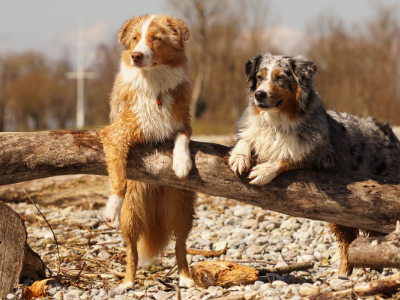The Benefits of Adding Fish to the Raw Diet

An incredibly valuable protein source that pet owners often miss is fish. Did you know that fish is packed with omega 3 fatty acids? It's a low-fat, high-protein food with a great polyunsaturated fat profile (the good fats). Most animals, including humans, are not getting enough omega 3 in their diet.
The two most commonly known and important omega 3’s are eicosapentaenoic acid (EPA) and docosahexaenoic acid (DHA). For starters, DHA makes up approximately 25% of the mammalian brain. So if your pet isn't getting enough, it could affect behavior, nervous system function, and an array of other systems including the digestive, reproductive and endocrine systems.
Is Your Dog Happy? Part 2: Creating Activities for Your Dog

Understanding your dog’s precursors to his or her “fight or flight” reaction is crucial to building a trusting relationship between you two. As simple as this sounds, if you don’t understand these “precursors,” often dogs will appoint themselves with the task of assigning behavioural actions they deem best. Ultimately, they want to be assured that you know what is best for them and will keep them safe.
Is Your Dog Happy?

We all know that a healthy pet means fewer vet bills and the easiest way to promote well-being in your dog is through a nutritious diet but is that the only component necessary? What about exercise, playtime, proper shelter, etc? All of these contribute to the well-being of your dog too. So, is he happy? How would you know if he/she is? And for those who don’t have a dog, yes, dogs have emotions too!
So we know nutritious foods are only one aspect, particularly 3P Naturals (shameless plug!) but there are many signals that your dog may be showing you that will help you determine whether or not he/she is happy.
Feline Diabetes: Part 2

Last week, we talked about feline diabetes, what it is and what can cause it. Now, let's take a brief look at what you can do to prevent and manage this common cat disease!
Tips for preventing feline diabetes:
-
Ditch the kibble. We know it’s convenient but it's not going to do you or your cat any favors. The more glucose that is produced in the body, the higher the risk of obesity and diabetes.
-
Raw diet! A meat diet is naturally high in protein which is the most important source of energy for obligate carnivores like cats. A high protein, low carbohydrate diet will help maintain a healthy metabolic rhythm for your cat for his lifetime. Protein helps to maintain blood sugar better than fat or carbohydrate. The best insurance you could ask for!
-
Exercise. So important! Your cat’s metabolic function will often directly correlate with your cat’s exercise regime and diet. Be sure to provide playtime for your indoor cat for extra exercise.
Feline Diabetes: Part 1

Has your cat been diagnosed with diabetes? Not exactly fun! So what now? Here's what you need to know:
Feline diabetes (Mellitus) is a disease characterized by a cat's inability to either produce adequate insulin or use insulin properly to stabilize its blood sugar levels. Common symptoms of feline diabetes are increased urination, increased thirst, overweight, and lethargy.


